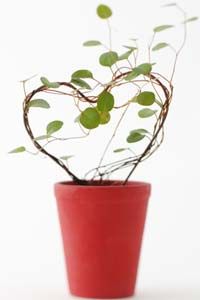How to Grow Trained Ivy Topiary
If you're planning to create a trained ivy topiary masterpiece for your home, first determine where you will put it. The amount of space you have will help determine the size of your creation, and the style of the area should help you pick a design. You can create various effects and make topiary mobile with containers. When choosing a container, pick one that is the right size for your plant and will allow your plant to drain, but not so much that it can't retain the water it needs. It's also a good idea to pick a sturdy container with feet or wheels, which encourages air circulation throughout the pot.
Creeping houseplants with small or medium-sized leaves like Hendra helix (English ivy) are best suited for this type of topiary. Select plants with bendable stems so you can train them to grow on frames. Creating this type of topiary with multiple plants cuts the time it takes for the plant to cover the frame. Plus, if one of the plants dies, you can easily cover it up with the others.
Advertisement
Hobbyists can create a small, tabletop trained ivy topiary in less than an hour. You will need long, trailing plants, a pot, soil, and florist's wire or twist ties. You'll also need your frame. You can buy one to save time, but if you'd like to save the expense and expand your options, make your own frame out of flexible, rust-resistant wire. Tape, spooling or florist's wire and plastic-coated wire twist ties may be used if you want to strengthen your frame. Wooden stakes, chicken wire and a hot glue gun could also be useful to make more complex frames. The only tools you'll need are wire cutters and pliers and, since the ends can be sharp, gloves to protect your hands.
Here's how to make a basic hoop frame:
- Start with a piece of wire long enough to create the size hoop you want plus double the height of your pot and a few inches for a base.
- Shape the wire into a circle, leaving an equal length of wire at each end. You can create a perfect circle by wrapping the wire around a container like a coffee can.
- Twist the ends of the wire together to create a straight support that's the same length as the height of the pot you want to use for the plant. The shape of your frame should resemble a lollipop at this point. You can reinforce the stem of your frame with tape or florist's wire if necessary.
- Bend the ends of the wire to form a base to support the frame in the pot.
Next, add your plant to finish your project. With your frame in the pot, fill the pot with soil and add your transported trailing plants. It is best to place the plants next to each side of the frame, where you will attach them. Wrap the plants around the circle, attaching them with florist's wire. Attach the wire or ties as loosely as possible, but tight enough to keep the plant wrapped around the wire.
